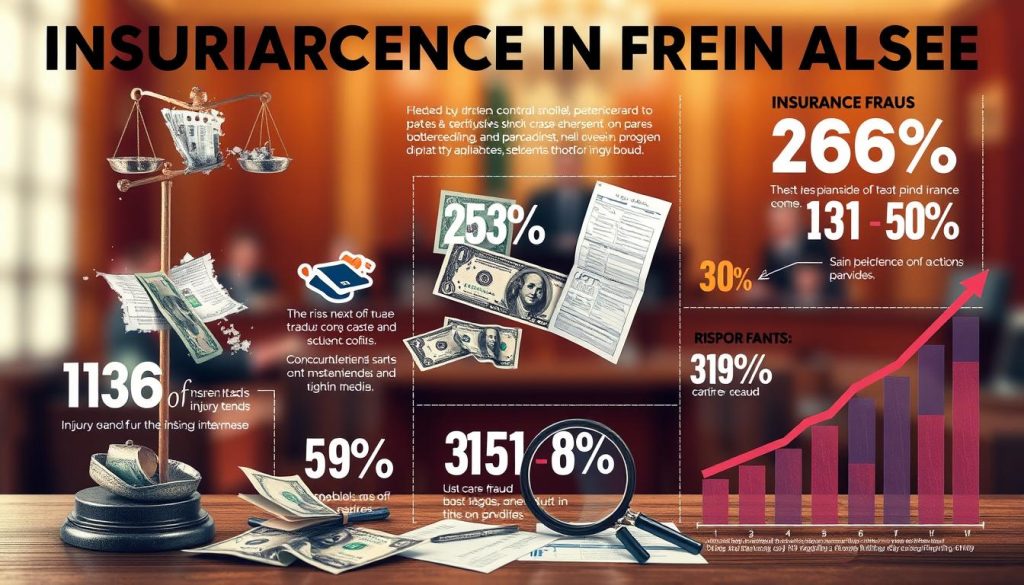In the complex world of insurance claims, a worrying trend has emerged: insurance fraud in injury cases. Criminals are now trying to cheat the system by making up accidents, exaggerating damages, and lying to insurers1. This issue is a big problem for the insurance industry’s trust and makes it hard for real claimants to get what they need.
The difference between real claims and scams can be hard to see. Clever people have found ways to fake incidents and make up damage claims1. These actions hurt the trust between insurers and their clients. It’s very important to tackle this issue to protect the insurance industry and the public from these dishonest acts.
Key Takeaways
- Insurance fraud in injury cases costs the U.S. $308.6 billion annually, making up 10% of property-casualty insurance losses1.
- Medicare fraud alone amounts to $60 billion per year in financial losses1.
- California loses over $15 billion yearly to insurance fraud, costing each person approximately $500 annually1.
- Insurance fraud is the second most costly crime in the U.S. after tax evasion1.
- Suspicion of insurance fraud affects 78% of consumers, with 32% reporting being victims of scams1.
- https://criminalinjurylaw.com/legal-conspiracy-theories-how-the-system-is-rigged-against-victims-13/
Uncovering Insurance Fraud Cases: Recognizing Deception
Spotting insurance fraud needs a sharp eye and deep knowledge of tricks. Criminals use staged incidents, exaggerated damages, and fake medical records to cheat insurers2. These scams cost the industry millions, making honest policyholders pay more and risking the industry’s stability2.
Fraudulent Claims and False Reports
Fraudsters work hard to make up claims, creating fake reports and altering evidence3. They pad medical bills and stage accidents, using tech to make their lies believable3. Insurers must watch closely to catch these scams, from over-stating damages to making up incidents.
Fraudulent Tactics
The use of artificial intelligence (AI) has made fighting insurance fraud harder3. With AI, scammers can fake voices, create convincing medical evidence, and improve their phishing tricks3. This makes it tough for insurers to tell real claims from fake ones, showing the need for fraud experts.
Impact on Insurers
Insurance fraud is a big problem, costing the industry billions each year2. Auto insurers lose at least $29 billion yearly, due to unknown drivers, under-estimated miles, and false garaging2. Healthcare fraud also costs a lot, with losses ranging from $68 billion to $300 billion annually2. These huge losses show how much fraud affects the industry and why it needs to be stopped.
Combating Strategies
Insurers are using new tech, like data analytics and working with law enforcement, to fight fraud2. By using these tools and hiring fraud experts, insurers can outsmart scammers and keep the industry safe2. Fighting fraud is key to protecting both insurers and policyholders.
The Legal Consequences of Insurance Fraud
Insurance fraud is a serious crime with harsh penalties. Those caught can face big fines and jail time. The penalties depend on the crime’s severity and the state’s laws.
In California, auto insurance fraud is a felony, with up to 5 years in prison4. Some auto fraud cases can be misdemeanors or felonies4. Felony sentences range from 16 months to 5 years, with fines up to $50,000 or twice the fraud amount4. Misdemeanor fraud can lead to up to 1 year in jail and a $1,000 fine4.
Insurance fraud costs the U.S. about $40 billion yearly, raising everyone’s premiums5. Workers’ compensation fraud is a big issue, with false claims for non-work injuries5. Health insurance fraud also causes premium losses and higher healthcare costs5.
It’s important to know the legal risks of insurance fraud. This helps prevent it and shows the value of honesty in the insurance world.
“Insurance fraud is the second most costly crime in the United States, following tax evasion.”5
Understanding insurance fraud’s consequences helps everyone make better choices. This leads to a fairer and more honest insurance system.
insurance fraud cases: A Growing Concern
Insurance fraud is a big problem that keeps getting worse. Criminals are finding new ways to cheat the system. This fraud hurts insurance companies a lot and makes people doubt the industry6.
Worldwide, 74% of insurers say fraud is getting worse or staying the same6. Also, 85% see no change or an increase in fraud when checking claims6.
Insurance fraud costs American consumers at least $308.6 billion each year. This is about 10% of all property-casualty insurance losses7. Medicare fraud alone costs $60 billion a year7.
Many people, 78%, worry about insurance fraud7. And 32% think they’ve been scammed by auto insurance7.
Insurance fraud also means higher prices for everyone. Insurers have to raise rates to cover their losses7. For auto insurance, 72% of those who think they were scammed see their rates go up7.
This loss of trust can affect many areas. For example, 78% of people haven’t heard about windshield scams7.
Insurers are fighting back, with 78% having teams to investigate fraud6. Also, 82% teach their claims assessors to spot fraud6. But, 68% think fraud will keep getting worse in the next few years6.

Stopping insurance fraud needs a strong plan. This includes new tech and using data7. Already, one-third use AI to find fraud7. As the industry changes, it’s key for insurers to keep up to protect their customers and keep the system honest.
Strategies for Combating Insurance Fraud
Insurance fraud costs the United States a huge $308.6 billion each year8. It includes lying on insurance forms and faking accidents for money8. Insurers are using new tech and data to fight this problem.
Technological Advancements and Data Analytics
The insurance world is using tech to fight fraud9. Almost all insurers use anti-fraud tools, especially for car and property claims9. Tools like predictive analytics and AI help spot fraud quickly.
Pilotbird is leading the way with its fraud-fighting tools. They help find and stop fraud early.
Data is key in the fight against fraud89. Insurers use big data to find suspicious claims. They also work with groups like the NAIC to share fraud tips9.
The fight against fraud is ongoing, but the industry is making progress89. By using new tech and data, insurers can keep everyone safe from fraud89.

“The insurance industry’s focus on new ideas and working together is key to keeping the insurance system honest and fair.”
Conclusion
The battle against insurance fraud in injury cases is crucial. It needs the help of insurers, policyholders, and regulators. With fraud costing over $40 billion a year in the U.S10., it affects everyone’s insurance costs and access.
Fraud, like staged accidents and false claims11, is a big problem. But, the insurance world is fighting back with new tech like predictive analytics10. By working together, they can share info and fight fraud better.
In the U.S., insurance fraud is a serious crime with big penalties10. The NAIC and state departments are also fighting fraud10. Teaching people about fraud’s risks helps prevent it too10.
To beat insurance fraud, we need a mix of tech, laws, and public education. By using smart data and building trust, the insurance world can protect everyone’s coverage.
FAQ
What is insurance fraud and how does it impact the industry?
Insurance fraud is when people lie to insurance companies. They might say they were in an accident or exaggerate damage. This can cost the industry a lot of money, making honest people pay more.
What are some common tactics used by insurance fraudsters?
Fraudsters often stage accidents or make up damage. They might also fake medical records or use AI to make fake evidence. These tricks are getting harder to spot.
How do insurers combat insurance fraud?
Insurers use new tech like data analytics to fight fraud. They also work with police to catch and stop fraudsters. Experts in fraud detection play a big role in this fight.
What are the legal consequences of insurance fraud?
Insurance fraud is a big deal and can lead to serious penalties. People caught might face fines or even jail. The punishment depends on the fraud’s size and the laws in their state.
How widespread is the problem of insurance fraud in the United States?
Insurance fraud is a big problem in the US. It costs consumers over 8 billion a year. Medicare fraud alone is billion. Many people think they’ve been scammed by insurance companies.

